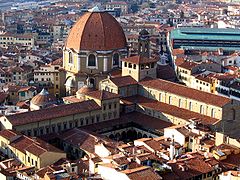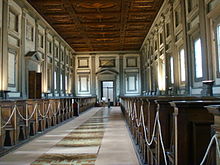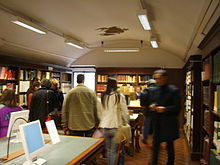- Laurentian Library
-
The Laurentian Library (Biblioteca Medicea Laurenziana) is a historical library in Florence, Italy, containing a repository of more than 11,000 manuscripts and 4,500 early printed books.[1] Built in a cloister of the Medicean Basilica di San Lorenzo di Firenze under the patronage of the Medici pope, Clement VII, the Library was built to emphasize that the Medici family were no longer mere merchants but members of intelligent and ecclesiastical society. It contains the manuscripts and books belonging to the private library of the Medici family. The library is renowned for the architecture planned and built by Michelangelo and is an example of Mannerism.[1][2][3]
Contents
Architecture
The Laurentian Library was commissioned in 1523 and construction began in 1525; however, when Michelangelo left Florence in 1534, only the walls of the reading room were complete. It was then continued by Tribolo, Basari, and Ammannati based on plans and verbal instructions from Michelangelo. The library opened by 1571. In this way, the library integrates parts executed by Michelangelo with others built much later in an interpretation of his instructions. The Laurentian Library is one of Michelangelo's most important architectural achievements. Even Michelangelo's contemporaries realized that the innovations and use of space in the Laurentian Library were revolutionary.[3]
The admirable distribution of the windows, the construction of the ceiling, and the fine entrance of the Vestibule can never be sufficiently extolled. Boldness and grace are equally conspicuous in the work as a whole, and in every part; in the cornices, corbels, the niches for statues, the commodious staircase, and its fanciful division-in all the building, as a word, which is so unlike the common fashion of treatment, that every one stands amazed at the sight thereof. – Giorgio Vasari.[4]
The two-story Quattrocento cloister was to remain unchanged by the addition of the library. Because of this, certain features of Michelangelo’s plan such as the length and width were already laid out. Therefore walls were built on already pre-existing walls and cloisters. Because the walls were built on pre-existing walls, recessing the columns into the walls was a structural necessity. This also led to a unique style and pattern that Michelangelo takes advantage of.[2]
Vestibule
The vestibule, also known as the ricetto, is 19.50 m. long, 20.30 m. wide, and 14.6 m. tall (31 by 34 by 44 feet).[3] It was built above existing monastic quarters on the east range of the cloister, with an entrance from the upper level of the cloisters. Originally, Michelangelo had planned for a skylight but the Pope believed that it would cause the roof to leak so clerestory windows were incorporated into the west wall. Blank tapering windows framed in peitra serena, circumscribe the interior of the vestibule, separated by paired columns set into the wall.[2]
Lit by windows in bays that are articulated by pilasters corresponding to the beams of the ceiling, with a tall constricted vestibule (executed to Michelangelo's design in 1559 by Bartolomeo Ammanati[1]) that is filled with a stair that flows down from the library itself, the Library is often instanced as a prototype of Mannerism in architecture.[5]
Staircase
The plan of the stairs changed dramatically in the design stage. Originally in the first design in 1524, two flights of stairs were placed against the side walls and formed a bridge in front of the reading room door. A year later the stairway was moved to the middle of the vestibule. Tribolo attempted to carry out this plan in 1550 but nothing was built. Ammannati took on the challenge of interpreting Michelangelo’s ideas to the best of his ability using a small clay model, scanty material, and Michelangelo’s instructions.[3]
The staircase leads up to the reading room and takes up half of the floor of the vestibule. The treads of the center flights are convex and vary in width, while the outer flights are straight. The three lowest steps of the central flight are wider and higher than the others, almost like concentric oval slabs. As the stairway descends, it divides into three flights.[2][3]
Reading Room
The reading room is 46.20 m. long, 10.50 m. wide, and 8.4 m. high (152 by 35 by 28 feet). There are two blocks of seats separated by a center aisle with the backs of each serving as desks for the benches behind them. The desks are lit by the evenly spaced windows along the wall. The windows are framed by pilasters, forming a system of bays which articulate the layout of the ceiling and floor.[3]
Because the reading room was built upon an existing story, Michelangelo had to reduce the weight of the reading-room walls. The system of frames and layers in the walls’ articulation reduced the volume and weight of the bays between the pilasters.[3]
Beneath the current wooden floor of the library in the Reading Room is a series of 15 rectangular red and white terra cotta floor panels. These panels, measuring 8 foot-6-inches (2.6 m) on a side, when viewed in sequence demonstrate basic principles of geometry. It is believed that these tiles were arranged so as to be visible under the original furniture; but this furniture was later changed to increase the number of reading desks in the room.[6][7]
Interpretation
In the ricetto, critics have noted that the recessing columns into the walls made the walls look like taut skin stretched between vertical supports. This caused the room to appear as if it mimics the human body, which at the time of the Italian Renaissance was believed to be the ideal form. The columns of the building also appear to be supported on corbels so that the weight seems to be carried on weak elements. Because of the seemingly instability of the structure, the viewer cannot discern whether the roof is supported by the columns or the walls. This sense of ambiguity is heightened by the unorthodox forms of the tabernacle windows and of the architectural elements compressed together, creating a sense of tension and constrained energy.[2]
The dynamic sculpture of the staircase appears to pour forth from the upper level like lava and compress the floor space of the vestibule. In the central flight, the convex treads vary in width which makes the entire arrangement disquieting.[2]
In sharp contrast to the vestibule and staircase, the reading room’s evenly spaced windows set between pilasters in the side walls is amplified by natural light and gives it a serene, quiet, and restful appearance.[2]
Collection
In 1571, Cosimo I, Grand Duke of Tuscany, opened the still-incomplete Library to scholars.[1] Notable additions to the collection were made by its most famous librarian, Angelo Maria Bandini, who was appointed in 1757 and oversaw its printed catalogues. The Library conserves the Nahuatl Florentine Codex, the major source of pre-Conquest Aztec life. Among other well-known manuscripts in the Laurentian Library are the sixth-century Syriac Rabula Gospels; the Codex Amiatinus, which contains the earliest surviving manuscript of the Latin Vulgate Bible; the Squarcialupi Codex, an important early musical manuscript; and the fragmentary Erinna papyrus containing poems of the friend of Sappho.
See also
- Papyrus 35
- Papyrus 36
- Papyrus 89
- Uncial 0171
- Minuscule 619
References
- ^ a b c d Medicean-Laurentian Library. Encyclopædia Britannica. 2007.
- ^ a b c d e f g Fazio, Michael; Moffett, Marian; Wodehouse, Lawrence, Buildings across Time (London: Lawrence King Publishing Ltd, 2009), pp 308-310
- ^ a b c d e f g Lotz, Wolfgang; Howard, Deborah, Architecture in Italy, 1500-1600 (New Haven: Yale University Press, 1995), pp 91-94
- ^ Vasari, Giorgio; Blashfield, Edwin Howland; Blashfield, Evangeline Wilbour; Hopkins, Albert Allis, Lives of Seventy of the Most Eminent Painters, Sculptors, and Architects (New York: C. Scribner's Sons, 1909), pp. 115-116
- ^ "Vestibule of the Laurentian Library". Olga's Gallery. http://www.abcgallery.com/M/michelangelo/michelangelo66.html. Retrieved February 14, 2007.
- ^ Ben Nicholson, Jay Kappraff, and Saori Hisano, "The Hidden Pavement Designs of the Laurentian Library", pp. 87-98 in Nexus II: Architecture and Mathematics, ed. Kim Williams, Fucecchio (Florence): Edizioni dell'Erba, 1998.
- ^ Rosin, Paul L.; Martin, Ralph R. (2003). "Hidden Inscriptions in the Laurentian Library" (PDF). Proceedings of Int. Soc. Arts, Mathematics, and Architecture (ISAMA): 37–44. http://ralph.cs.cf.ac.uk/papers/Geometry/Laurentian.pdf. Retrieved 2007-02-16.
External links
- Official website (in English)
- Great Buildings on-line: Laurentian Library
- Photos of the Library and vestibule, with Giorgio Vasari's remarks
- Art of the States: Octet for Strings 'La Laurenziana' Work by composer Henri Lazarof inspired by the library
- Laurentian Library
Coordinates: 43°46′28″N 11°15′12″E / 43.774521°N 11.253374°E
Michelangelo Key: *Attributed · †LostSculptures Florence, c. 1488–92†Head of a Faun (c. 1488) · Madonna of the Stairs (c. 1491) · Battle of the Centaurs (c. 1492) · Crucifix (1492)Ark of St Dominic (1494–95)†Sleeping Cupid (1496) · †Standing Cupid · Bacchus (1496–97) · Pietà (1499–1500) · David (1501-04) · Madonna of Bruges (1501–04) · St. Paul (1503–04) · St. Peter (1503–04) · Pius (1503–04) · Taddei Tondo (c. 1503) · Pitti Tondo (c. 1503) · St. Matthew (c. 1505)Tomb of Pope Julius IIMoses (c. 1513–15) · Rebellious Slave (1513–16) · Dying Slave (1513–16) · Young Slave (c. 1519–36) · Bearded Slave (c. 1519–36) · Atlas Slave (c. 1519–36) · Awakening Slave (c. 1519–36) · The Genius of Victory (c. 1532–34) · Rachel (1545) · Leah (1545)Medici Chapel (1519–34)Cristo della Minerva (Christ Carrying the Cross) (1519–20) · Crouching Boy (c. 1530-34) · Brutus (1540) · *Palestrina Pietà (1550) · Florentine Pietà (c. 1550) · Rondanini Pietà (1552–64)
Paintings *The Torment of Saint Anthony (c. 1487-88) · Manchester Madonna (c. 1497) · Doni Tondo (c. 1503–06) • †Battle of Cascina (1504) · The Entombment (c. 1505) · †Leda and the Swan (1530)
Ceiling (1508–12; including Separation of Light from Darkness, Creation of Adam, Prophet Jonah, Prophet Jeremiah, Prophet Daniel, Prophet Isaiah, Prophet Joel, Prophet Ezekiel, Prophet Zechariah) · The Last Judgment (1534–41)Cappella Paolina frescoes (1542–50)Architecture Piazza del Campidoglio (1538) · Palazzo Farnese (1546) · St. Peter's Basilica (1546–1564) · San Giovanni dei Fiorentini (1559–60) · Porta Pia (1561–65) · Santa Maria degli Angeli e dei Martiri (1561–)Works on paper Epifania (c. 1550–53)Milieu Cecchino dei Bracci · Tommaso dei Cavalieri · Vittoria Colonna · Ascanio Condivi · Sebastiano del Piombo · Febo di Poggio · Luigi del Riccio · Gherardo PeriniCategories:- Buildings and structures completed in 1559
- Libraries in Italy
- Buildings and structures in Florence
- House of Medici
- Renaissance architecture in Florence
Wikimedia Foundation. 2010.





